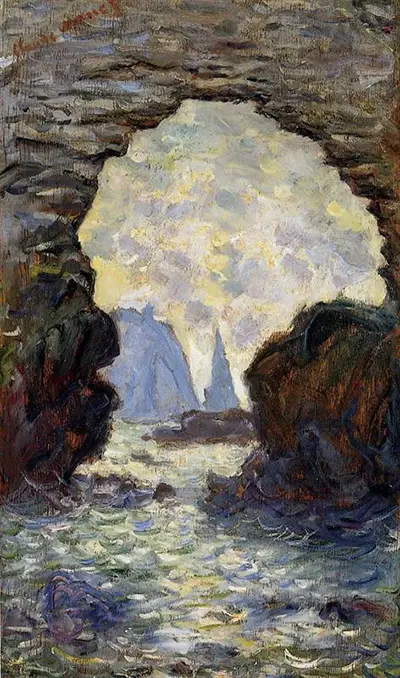Oscar-Claude Monet (1840 – 1926) was a French artist and a founder of French Impressionist painting. Throughout his career, Claude Monet produced countless oil paintings and pastel artworks. Claude Monet's work, The Rock Needle seen through the Porte d'Aumont, portrays a rock formation off the coast of France. The 19th-century artist lived in Giverny, France, from 1883, where he purchased a house and property and began a vast landscaping project. Claude Monet was also fascinated by the famous rock formations at Etrétat, on the Normandy coast near Le Havre. The artist paid the resort several extended visits and produced several works views of this location. The Rock Needle seen through the Porte d'Aumont is plausibly one of these.
The Rock Needle seen through the Porte d'Aumont employs a wide tonal range, which contrasts the heavily rock formation with the strongly tinted yellow sky seen through the formation. The sea is also heavily tinted to portray glints of light reflected by the ocean waves. The work features a narrow pallet range with a dominance of blue and earthy tones. The medium of oil paint is applied thickly, in directional strokes, characteristic of Impressionist art. Claude Monet also demonstrates another technique popular throughout the Impressionist movement: 'worrying' over outlines, contours and shading effects, where the application of paint is not limited to the outlines of the details it illustrates.
Claude Monet's approach is experimentation and amplifies a sense of flow, freedom and expansion often distinctive of his works. The waves in the bottom third of the composition create a sense of movement that escapes the confines of the rock formation which frames the top two thirds of the work. The Impressionists endeavoured to create an impression as much as an artwork. In The Rock Needle seen through the Porte d'Aumont, Claude Monet appears be concerned with to projecting a feeling of a coastal scene which is not limited to a visual experience.
Impressionism was a movement that began in the late 1960s by a group of artists including Claude Monet, Auguste Renoir and Paul Cezanne and is an important movement in the history of art in the modern period. Impressionism was a separation from the conservative approach to art that dominated the art world throughout the Vanitas tradition. Claude Monet was a consistent and prolific practitioner of the Impressionism's philosophy of expressing the artist's perceptions before nature, particularly as applied to plein-air landscape painting. The 19th-century artist's works have achieved worldwide renown.
The term "Impressionism" is derived from the title of Claude Monet's painting Impression, soleil levant (Impression, Sunrise), which was exhibited in 1874 in the first of several independent exhibitions mounted by Claude Monet and fellow artists as an alternative to the Salon de Paris. Impressionist artists believed that art should represent specifically contemporary sensibility. The movement and its artists, such as Claude Monet, became very influential and developed into a division within the wider world of European culture.


